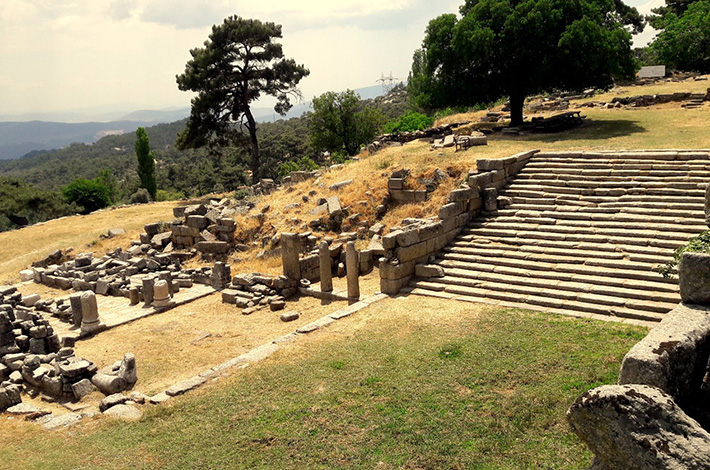In antiquity, the inhabitants of south-western Anatolia were known as Carians. They spoke a language belonging to the Indo-European family, Carian, which was similar to that of their neighbours, the Lycians. Their country, Caria, was bordered by the Aegean Sea to the south and west, the Büyük Menderes to the north, and the Dalaman Stream (ancient Indus) to the east. From 546 BC, Caria came under the rule of the Persian Empire and was ruled by satraps appointed by Persian kings. The first of these was Hecatomnos (c. 392-377 BC). His five children who followed him are known as the Hekatomnids. Labraunda was the most important sanctuary in Western Caria. The period between the 4th and 3rd centuries BC was particularly significant, during the rule of Maussollos (377-352 BC) and his brother Idrieus (351-344 BC) as satraps of Caria. He and his brother transformed Labraunda into a family sanctuary and constructed the Temple of Zeus, two large Androns (religious dining halls), the North Stoa, the Oikoi Building, the South Propylon (gateway building) and the Doric Building. Given that few additions have been made to the architectural facade of the sanctuary over the following three hundred years and that very little was constructed in the Roman and later periods, Labraunda can still be regarded as a genuine Hekatomnids site. During the Hecatomnids, Labraunda was an autonomous sanctuary and pilgrimage site, overseen by its own priests and accessible to the people of all the surrounding villages. People travelled to the site on foot or on horseback. The nearest town, Mylasa (today Milas), is 14 kilometres away. The sanctuary was reached from Mylasa by an 8-metre-wide stone-paved road called the Sacred Way. Religious festivals were celebrated in the sanctuary for five days every year, during one of which Maussollos narrowly escaped an assassination attempt in 355 BC. Labraunda was a sanctuary for centuries before the 4th century BC. The earliest sherds of pottery recovered during excavations date to the mid-7th century BC, although the sanctuary itself may be even older. The idea that Labraunda was considered sacred is suggested by a remarkable rock just above the sanctuary. This rock appears to have been split in two by a lightning strike. Given the occurrence of stormy rains in the area, it is possible that people in the neighbourhood believed that this rock was the dwelling place of the sky god. A spring is situated in close proximity to the split rock, and a fountain structure was constructed in the area in ancient times. The name of the sanctuary is written as Labraunda, but the spellings Labranda, Lambraunda and Labraynda are also correct. The reason for this discrepancy is that the name changed over time in antiquity, and both the ancient sources and the inscriptions at the site contain all of them. The earliest known written source, Herodotus, who lived in the 5th century BC, recorded the name as Labraunda. This is the most common spelling used in the Hellenistic period (3rd century BC - 1st century BC). However, it seems that the name was officially called Lambraunda for a short time in the 4th century BC, as the name of the god Zeus Lambraundos is mentioned in the inscriptions. During the Roman period, from the late 1st century BC, the spelling Labranda became increasingly common. In Latin, Pliny the Elder (1st century) wrote the name of the god as Labrayndus, in which case the place was called Labraynda in the sources he used. Until 1960, the inscriptions, sculptures and architectural fragments found during excavations were either taken to the Bodrum Museum or left at the site. The Izmir Archaeological Museum houses a collection of ceramics and other small finds, including Carian inscriptions. Some recent excavations have yielded finds that are displayed at the Milas Museum.
MİLAS LABRAUNDA ARCHAEOLOGICAL SITE


